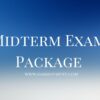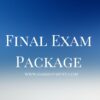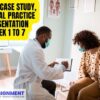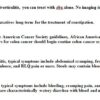Description
NR 511 Midterm Exam Study Guide 2
NR 511 Week One
- Define diagnostic reasoning.
- Identify subjective & objective data.
- Identify the components of the HPI.
- Develop an appropriate differential.
- Accurately describe why every procedure code must have a corresponding diagnosis code.
- Identify the three components required in determining an outpatient, office visit E&M code.
- Describe the differences between medical billing and medical coding.
- Compare and contrast the two coding classification systems that are currently used in the U.S. healthcare system.
- Discuss how specificity, sensitivity, and predictive value contribute to the usefulness of diagnostic data.
- Discuss the elements that need to be considered when developing a plan.
- Describe the components of medical decision making in E&M coding.
- Correctly order the E&M office visit codes based on complexity from least to most complex.
- Define the components of a SOAP note.
- Discuss a minimum of three purposes of the written history and physical in relation to the importance of documentation.
- Correctly identify a patient as new or established given the historical information.
- Correctly identify the most specific ICD-10 code with the information given
- Explain what a “well rounded” clinical experience means.
- Discuss the maximum number of hours that time can be spent “rounding” in a facility.
- Discuss nine things that must be documented when inputting data into clinical encounter logs.
- Explain each part of the acronym the SNAPPS presentation.
NR 511 Week 2
- Identify the most common type of pathogen responsible for acute gastroenteritis.
- Identify when stool studies are warranted
- Describe the difference between Irritable Bowel Disease (IBS) and Inflammatory Bowel Disorder (IBD).
- Discuss two common Inflammatory Bowel Diseases.
- Describe the characteristics of acute diverticulitis
- Discuss how the diagnosis of diverticulitis is nr 511 midterm exam
- Discuss colon cancer screening recommendations relative to certain populations.
- Describe an intervention for a patient with gastroenteritis.
- Discuss an appropriate treatment for prophylaxis or treatment of traveler’s diarrhea.
- Identify at least one effective treatment for Irritable Bowel Syndrome (IBS).
- Identify at least one prescription medication for the treatment of chronic constipation.
- Describe the component of the H&P that should be done for a patient with abdominal pain
- Describe the clinical characteristics and treatment options for GERD and AGE
- Discuss the difference between sensorineural and conductive hearing loss.
- Identify the triad of symptoms associated with Meniere’s disease.
- Identify at least two disorders that are considered to be disorders related to conductive hearing loss.
- Discuss treatment options for Meniere’s disease.
- Discuss Eustachian Tube Disorder, clinical features and treatments
- Identify which conditions warrant an ENT referral
- Compare and contrast otitis media and otitis externa
- Identify the symptoms associated with peritonsilarabcess.
- Identify the most common cause of viral pharyngitis.
- State the clinical features and treatments for each condition noted above.
- Identify the most common cause of acute nausea & vomiting.
- Discuss that the diagnosis of streptococcal pharyngitis can be made clinically based on the Centor criteria.
- Identify treatment options for Group A B-hemolytic streptococcal pharyngitis nr 511 midterm exam
- Discuss that the majority of dyspnea complaints are due to cardiac or pulmonary decompensation.
- Identify the most common bacterial cause of pharyngitis and state the clinical findings associated with the condition.
- Identify the clinical findings associated with mononucleosis.
- Explain the differences between intra-thorax and extra-thorax flow disorders.
- Identify at least three examples of flow and volume disorders (intra and/or extra thorax).
- Describe appropriate tests in the work up for dyspnea
- Describe the classes of asthma and treatments for each category nr 511 midterm exam
- Identify the respiratory characteristics of chronic bronchitis, asthma and COPD in terms of clinical findings seen on exam and as well as PFTs
- Know what the CURB-65 tool is and how it is nr 511 midterm exam
- Define and describe chronic cough
- Identify medications that can cause cough
- State the subjective and objective findings seen with asthma, COPD, sinusitis, allergic rhinitis, vasomotor rhinitis and influenza.
- Identify treatments options for the above conditions
NR 511 Week 3
- Differentiate between the following common rashes: rubeola, rubella, varicella, roseola, 5ths disease, pityriasis rosea, hand, foot and mouth disease and molluscum contagiosum.
- Identify common characteristics in a rash caused be Group A Strep.
- Differentiate between the following tineas: pedis, cruris, corporis and unguium and describe an appropriate treatment.
- Identify the virus that causes warts.
- Differentiate between atopic and contact dermatitis and give examples of each.
- Identify common medications used to treat TB, their mechanism of action and side effects
- Identify strengths of corticosteroids and when each is appropriate
- Know normal response to TB skin test and what it means nr 511 midterm exam
- State common reasons for decreased response to TB skin testing
- Identify strengths of tretinoin and when each is appropriate
- Identify the various types of lesions based on their characteristics
- Differentiate between viral, allergic, bacterial, toxic and HSV conjunctivitis.
- Discuss which chemical injury is …..with the most damage and highest risk to vision loss.
- Identify common characteristics associated with blepharitis, chalzion and hordeolum.
- Recognize common eye emergency conditions that require emergency room evaluation.
- Identify types of cataracts and their characteristics








